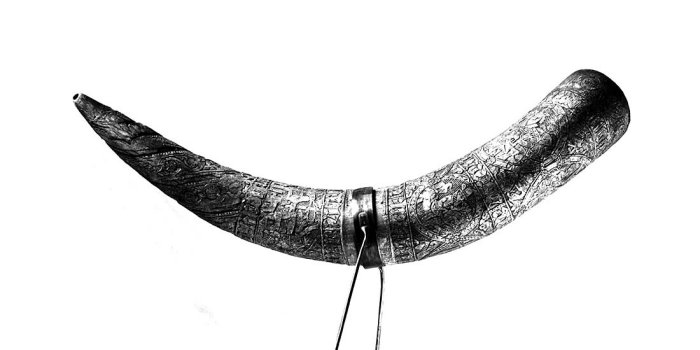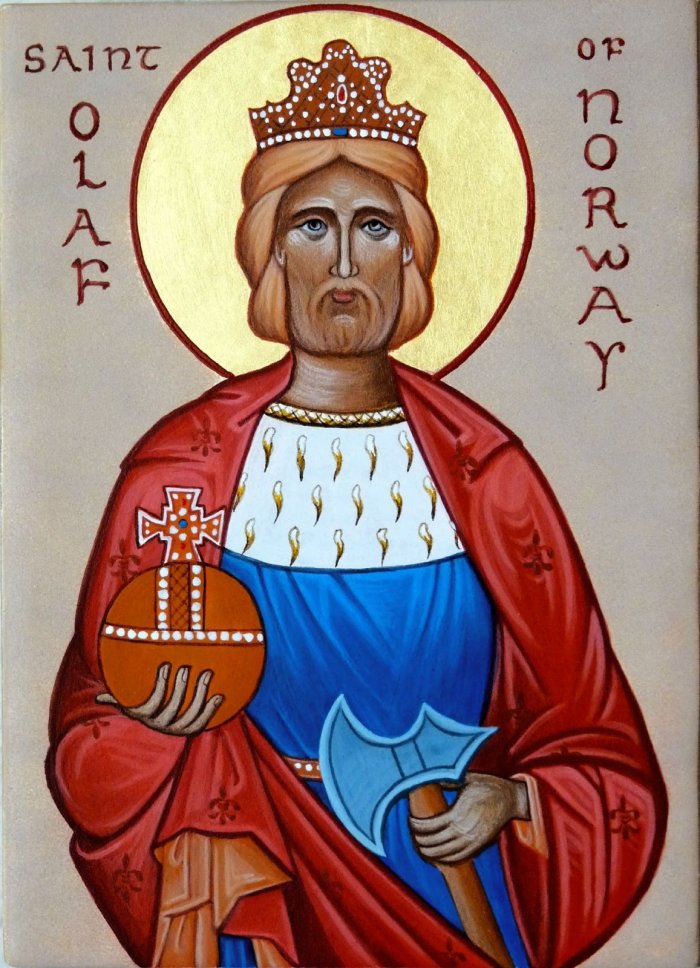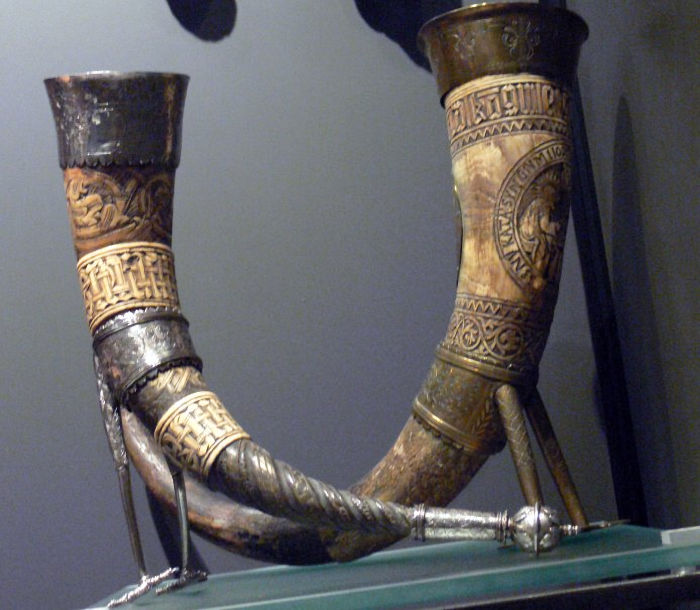Ancient Icelandic Drinking Horn Reveals An Interesting Story About Saint-King Olaf
Ellen Lloyd - Ancient Pages.com - Drinking horns were popular among many different ancient cultures. They were used by Scandinavians, Greeks, Romans, Thracians, Scythians, and people in Africa. People have been drinking from horns for at least 2,600 years.
Drinking horns were status symbols and widely used as gifts, both in the Middle Ages and in the centuries after the Reformation. The picture shows one of the few drinking horns that have remained in Icelandic possession, called the "Three kings horn." It shows Saint Olav juxtaposed with Old Testament kings Solomon and David. Photo: National Museum of Iceland
During the Middle Ages, drinking horns were considered precious objects with great symbolic value. Drinking horns had names and were a symbol of status. Medieval people believed the horns came from the foot or claw of the mythical griffin, a legendary creature portrayed as a mix between an eagle and a lion.
Due to their value, many drinking horns were stolen and ended up in princely cabinets.
"Mediaeval drinking horns are scattered in collections throughout northern Europe. They were coveted collectibles. Medieval art often remained in churches until it went out of fashion or was removed due to errors in iconography, whereas drinking horns ended up in princely collections and cabinets and have kept their status to the present day," says Associate Professor Margrethe Stang, from the Norwegian University of Science and Technology's (NTNU) Department of Art and Media Studies.
St.Olaf – Patron Of Norway
Olaf II Haraldsson (995 – 29 July 1030) was a King of Norway from 1015 to 1028.
He was a martyr and became later declared a saint king who wanted to free Norway from the domination of the Danes and the Swedes.
In 1019, St.Olaf defeated Earl Sweyn at Nesje and requested that missionaries be sent from England to advance the Christianization of Norway. Owing to the harsh nature of his rule, he faced a rebellion of nobles in 1029. Through the aid of the formidable King Canute of Denmark, the rebels overthrew him and drove him into exile in Russia.
St. Olaf returned to Norway, but he was slain in battle at Stiklestad, on July 29 in 1031.
During his lifetime, St.Olaf was not very popular and was not considered especially holy. However, St. Olaf was revered after death owing to reports of miracles occurring at his tomb. He was greatly respected as a champion of Norwegian independence, and his shrine became the foundation of the cathedral of Trondheim, a popular pilgrimage place during the Middle Ages. He is the patron of Norway and was canonized in 1164.
Depictions Of St.Olaf On Icelandic Drinking Horns
Stang, an art historian, studied how St. Olav has been depicted on Icelandic drinking horns.
The Reformation in the 1500s brought an end to the worship of Catholic saints, and St. Olav was no longer to be considered a saint. The motifs on the Icelandic drinking horns show that the saint-king acquired a new role.
St. Olav is portrayed on the drinking horns "alongside biblical ideal kings like King Solomon and King David and historical figures like Charlemagne and Constantine, the first Christian emperor of the Roman Empire. It's clear that the old Catholic saint is being depicted in a new context as a historical king and not a saint-king. He was given a new role. The horns show a shift in the perception of Olav," Stang says.
Even after the Reformation, Stang suspects that Olav was considered a saint.
"When Christian IV traveled to Norway in 1599, we know that a toast to St. Olav was raised during a peasant wedding. The fact that a culture existed to toast the saints gives great context for the drinking horns. The horn motifs reflect their use and show their close relationship," she says.
Norwegian drinking horns are smooth and have inscribed metal mountings, while Icelandic ones consist only of the horn. However, they are richly decorated with reliefs carved into the horn itself.
Two Icelandic drinking horns from around 1600 in the Danish National Museum. Credit: Christian Bickel - CC BY-SA 2.0 de
Why St. Olav is depicted on so many Icelandic drinking horns is one of the questions that researchers have not yet answered
Stang believes St. Olav must have had a different status in Iceland than in Norway and that the importance of his being a Norwegian king must have been experienced differently.
"St. Olav was a popular saint across much of northern Europe, but I think there was a wide variation in how he was perceived. We might not have recognized the Olav that was worshipped in northern Germany, for example. The cult of saints had a stronger local stamp than we normally imagine," she says.
Stang relates a story from one of the Icelandic bishops' sagas, where Icelanders and Norwegians find themselves on a boat to Norway, discussing the saints.
The Norwegians tell the Icelanders that their saints are too weak and are "punished" for their harassment of the Icelanders. This saga "shows that the cult of the saints had many local and regional variants and that they were important for local identity," says Stang.
Written by - Ellen Lloyd – AncientPages.com
Copyright © AncientPages.com All rights reserved. This material may not be published, broadcast, rewritten or redistributed in whole or part without the express written permission of AncientPages.com
Expand for referencesMore From Ancient Pages
-
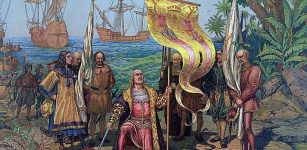 No Evidence Ancient Caribbeans Were Cannibals – Scientists Say
Archaeology | Aug 23, 2021
No Evidence Ancient Caribbeans Were Cannibals – Scientists Say
Archaeology | Aug 23, 2021 -
 Unique 2,000-Year-Old Decorated Roman Sandal Lost By Well-Cleaner Found In Spain
Archaeology | Oct 19, 2023
Unique 2,000-Year-Old Decorated Roman Sandal Lost By Well-Cleaner Found In Spain
Archaeology | Oct 19, 2023 -
 Dead Sea Scrolls Reveal Noah’s Ark Was Pyramid-Shaped
Archaeology | Jul 1, 2016
Dead Sea Scrolls Reveal Noah’s Ark Was Pyramid-Shaped
Archaeology | Jul 1, 2016 -
 Celtiberians: Intriguing Martial Culture And Their Skilled Warrior Infantry
Civilizations | Jul 13, 2024
Celtiberians: Intriguing Martial Culture And Their Skilled Warrior Infantry
Civilizations | Jul 13, 2024 -
 Mystery Of The Vanished Settlers Of Greenland – What Happened To The Lost Viking Colonists?
Books | Jul 22, 2023
Mystery Of The Vanished Settlers Of Greenland – What Happened To The Lost Viking Colonists?
Books | Jul 22, 2023 -
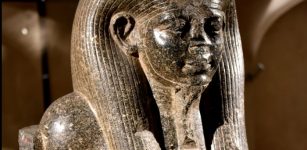 Hapi: Early Egyptian God Of The Nile And Bringer Of Fertility, Abundance And Life
Egyptian Mythology | Mar 20, 2019
Hapi: Early Egyptian God Of The Nile And Bringer Of Fertility, Abundance And Life
Egyptian Mythology | Mar 20, 2019 -
 8 Billion People: How Different The World Would Look If Neanderthals Had Prevailed
Featured Stories | Nov 18, 2022
8 Billion People: How Different The World Would Look If Neanderthals Had Prevailed
Featured Stories | Nov 18, 2022 -
 Easter Island Secrets: Giant ‘Pukao’ Stone Hats Reveal That Rapa Nui People Were Not Warriors
Archaeology | Dec 22, 2017
Easter Island Secrets: Giant ‘Pukao’ Stone Hats Reveal That Rapa Nui People Were Not Warriors
Archaeology | Dec 22, 2017 -
 On This Day In History: Attila The Hun Captures The City of Metz – On Apr 7, 451
News | Apr 7, 2017
On This Day In History: Attila The Hun Captures The City of Metz – On Apr 7, 451
News | Apr 7, 2017 -
 Anglo-Saxon Warlord’s Grave: Archaeologists And Metal-Detectorists Work Together
Archaeology | Oct 7, 2020
Anglo-Saxon Warlord’s Grave: Archaeologists And Metal-Detectorists Work Together
Archaeology | Oct 7, 2020 -
 Unique Ancient Man-Made Underground Structure In New England Puzzles Experts – Who Built It And Why?
Featured Stories | Aug 11, 2024
Unique Ancient Man-Made Underground Structure In New England Puzzles Experts – Who Built It And Why?
Featured Stories | Aug 11, 2024 -
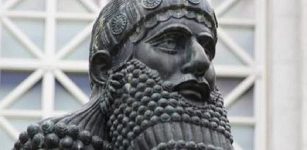 Hammurabi: Great King Of Babylon And His Code Of Justice
Historical Figures | May 14, 2017
Hammurabi: Great King Of Babylon And His Code Of Justice
Historical Figures | May 14, 2017 -
 1,800-Year-Old Legio VI Ferrata Military Camp Uncovered In Israel
Archaeology | Feb 21, 2024
1,800-Year-Old Legio VI Ferrata Military Camp Uncovered In Israel
Archaeology | Feb 21, 2024 -
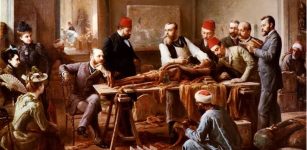 Why Did People Start Eating Egyptian Mummies? The Weird And Wild Ways Mummy Fever Swept Through Europe
Featured Stories | Jun 7, 2022
Why Did People Start Eating Egyptian Mummies? The Weird And Wild Ways Mummy Fever Swept Through Europe
Featured Stories | Jun 7, 2022 -
 Dark History Of Pömmelte, The German Stonehenge – What Can The Nebra Sky Disc And Archaeology Reveal?
Archaeology | Jul 3, 2018
Dark History Of Pömmelte, The German Stonehenge – What Can The Nebra Sky Disc And Archaeology Reveal?
Archaeology | Jul 3, 2018 -
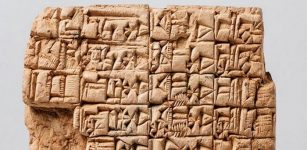 New AI Technique Will Help To Decode Long Lost Languages Of Ancient World
News | Oct 21, 2020
New AI Technique Will Help To Decode Long Lost Languages Of Ancient World
News | Oct 21, 2020 -
 Peculiar Ancient Ruins That Can Re-Write History Of Florida Found By Archaeologists
Featured Stories | Jul 28, 2024
Peculiar Ancient Ruins That Can Re-Write History Of Florida Found By Archaeologists
Featured Stories | Jul 28, 2024 -
 Mystery Of Pharaohs And Gods With Two Left Or Two Right Hands
Featured Stories | Oct 20, 2018
Mystery Of Pharaohs And Gods With Two Left Or Two Right Hands
Featured Stories | Oct 20, 2018 -
 Secrets Of Namibia’s Fairy Circles Solved – Self-Organizing Plants Are The Creators – New Theory
Archaeology | Oct 21, 2022
Secrets Of Namibia’s Fairy Circles Solved – Self-Organizing Plants Are The Creators – New Theory
Archaeology | Oct 21, 2022 -
 Barabar Caves: The Oldest Surviving Rock-Cut Caves With Acoustic Effects In India
Featured Stories | Jul 1, 2021
Barabar Caves: The Oldest Surviving Rock-Cut Caves With Acoustic Effects In India
Featured Stories | Jul 1, 2021

